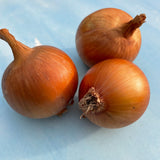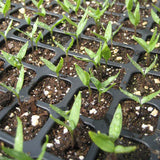
Grow-How: Long Live The Garden
Starting seeds this time of year can feel risky: Even if you've done your research, you never know when an early frost might creep in one night and steal all your precious garden crops away. But although fall weather is fickle, that doesn't mean you should stop growing for the season--on the contrary! There's still much to be done, many seeds to be sown, many veggies to be eaten. To make sure your garden lasts as long into the cold season as possible, turn to these three tactics.
 1. ROW COVER: Row cover is one of the most useful and versatile tools for your garden. Got pests? Use row cover. Want to prevent weeds? Use row cover. Need to trap some moisture? Row cover. It's also perfect for providing a warm, sheltered environment to protect plants from frost both at the beginning of the season and the end. For end-of-season extension, cover your plants when the temperatures start to drop and nighttimes are in the 40's. Keep row cover from touching the plants directly (this can hamper growth, cause rot, and fail to protect them from frost). We recommend using hoops, such as our pre-bent wire hoops. To use wire hoops, insert them into the ground about four feet apart before getting out the row cover. Center the row cover over the top of the hoops and let it drop down, leaving a one-foot lip along the ground. Weight the cover securely at each end and at each hoop end with bags of dirt or rocks. To access your plants, simply move the bags aside. Once temps start to get below freezing, add another layer to keep plants safe from freezing temperatures. Greenhouses and cold frames, though more costly, will have many of the same benefits.
1. ROW COVER: Row cover is one of the most useful and versatile tools for your garden. Got pests? Use row cover. Want to prevent weeds? Use row cover. Need to trap some moisture? Row cover. It's also perfect for providing a warm, sheltered environment to protect plants from frost both at the beginning of the season and the end. For end-of-season extension, cover your plants when the temperatures start to drop and nighttimes are in the 40's. Keep row cover from touching the plants directly (this can hamper growth, cause rot, and fail to protect them from frost). We recommend using hoops, such as our pre-bent wire hoops. To use wire hoops, insert them into the ground about four feet apart before getting out the row cover. Center the row cover over the top of the hoops and let it drop down, leaving a one-foot lip along the ground. Weight the cover securely at each end and at each hoop end with bags of dirt or rocks. To access your plants, simply move the bags aside. Once temps start to get below freezing, add another layer to keep plants safe from freezing temperatures. Greenhouses and cold frames, though more costly, will have many of the same benefits.
 2. COLD HARDY CROPS: In addition to protecting your crops, make sure you're planting the right ones. The secret to growing in four seasons is to focus on cold hardy crops that need only a proper planting schedule and layers of protection. For winter harvests, it's best to have a high tunnel or greenhouse full of greens, but for extension in spring and fall, low tunnels with row cover and plastic will bring the covered space down one or two growing zones, extending your season up to four weeks. New to growing in the shoulders? Be sure to plan ahead with proper timings of sowings and plantings! Read our helpful articles here and here. Some of our favorite varieties to plant in fall are hardy greens, such as chard, kale, arugula, lettuce, Asian greens, and mustards. August is also a great time to sow root crops for fall feasts and winter storage, including beets, carrots, radishes, and turnips. For a full list of fall harvest varieties, click here. Many of these veggies can be sown successively throughout the month, and although they are cold hardy, the use of row cover when temperatures dip will help them thrive. Plus, don't forget that fall is the time to plant cover crops, garlic, and flower bulbs.
2. COLD HARDY CROPS: In addition to protecting your crops, make sure you're planting the right ones. The secret to growing in four seasons is to focus on cold hardy crops that need only a proper planting schedule and layers of protection. For winter harvests, it's best to have a high tunnel or greenhouse full of greens, but for extension in spring and fall, low tunnels with row cover and plastic will bring the covered space down one or two growing zones, extending your season up to four weeks. New to growing in the shoulders? Be sure to plan ahead with proper timings of sowings and plantings! Read our helpful articles here and here. Some of our favorite varieties to plant in fall are hardy greens, such as chard, kale, arugula, lettuce, Asian greens, and mustards. August is also a great time to sow root crops for fall feasts and winter storage, including beets, carrots, radishes, and turnips. For a full list of fall harvest varieties, click here. Many of these veggies can be sown successively throughout the month, and although they are cold hardy, the use of row cover when temperatures dip will help them thrive. Plus, don't forget that fall is the time to plant cover crops, garlic, and flower bulbs.
 3. TIMELY HARVEST: Despite our best efforts, there is only so much cold most crops can handle. So after you've sown them, protected them, and tended them, make sure you get them out of the elements to enjoy. And don't worry about not having enough room in your stomach at once; fall is a great time to store your bounty for winter. While most roots are cold hardy, harvest them before a hard freeze and store them in a cool, dark, humid location. Make sure this location doesn't freeze as it can damage roots and make them spoil. Alternatively, you can heavily mulch carrots, parsnips, and beets and keep harvesting them through December. You can read more about how to store for winter here.
3. TIMELY HARVEST: Despite our best efforts, there is only so much cold most crops can handle. So after you've sown them, protected them, and tended them, make sure you get them out of the elements to enjoy. And don't worry about not having enough room in your stomach at once; fall is a great time to store your bounty for winter. While most roots are cold hardy, harvest them before a hard freeze and store them in a cool, dark, humid location. Make sure this location doesn't freeze as it can damage roots and make them spoil. Alternatively, you can heavily mulch carrots, parsnips, and beets and keep harvesting them through December. You can read more about how to store for winter here.
It's true that not all crops will survive the end of winter, and we end up having to say goodbye to some of our favorites. Nonetheless, there is still plenty of sowing, growing, and eating to do even as the days get shorter. Nothing lasts forever, but with proper garden planing, you can get pretty close!






